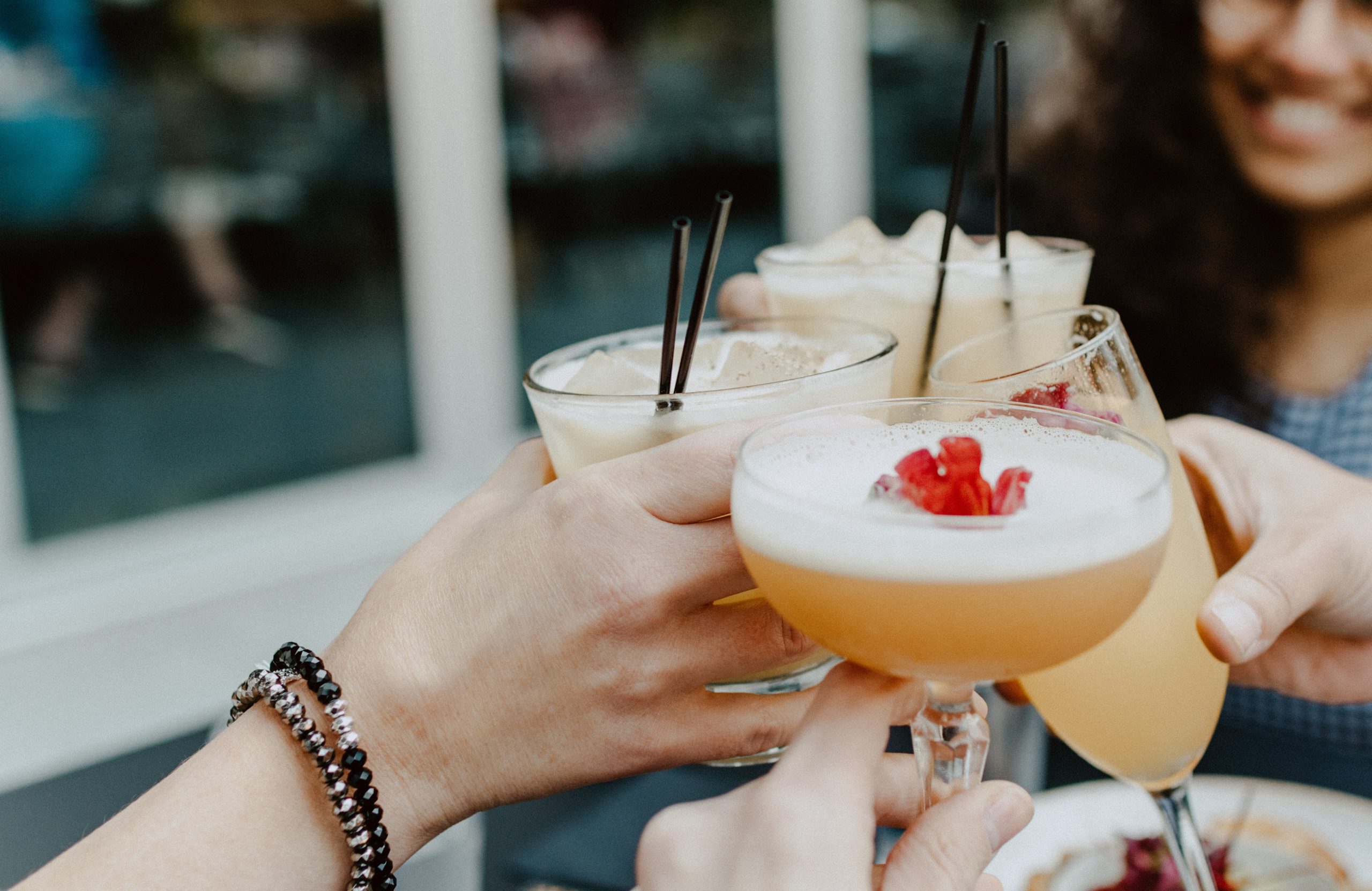Cheshire-based Fruits of the Forage makes award-winning wild preserves, cordials and spirits from fruit that would otherwise go to waste. Run by two brothers Bert and Fred Thorneycroft, they champion fresh, local produce through their veg boxes, run foraging events and work to conserve rare British fruit varieties by planting orchard trees. We spoke to Operations Director Bert about the fruits of their labour.
Bert –what inspired you and Fred to start Fruits of the Forage?
Bert Thorneycroft: My brother Fred started the business. We always loved the outdoors, nature, growing and cooking. Our mum was a keen cook and preserver, and she instilled a love of cooking in us. In our late teens, we woke up to wild food. Back then foraging was still quite niche and we started experimenting with wild fruits and herbs. We often made homebrew beers using things like nettle, mugwort and yarrow. These experimental brews were much to the disapproval of our grandfather, who worked in the brewing industry!
He was another inspiration for us. He made a lot of traditional recipes such as rabbit pie, brawn and jugged hare (he grew up in rural mid-Wales). Going even further back his father was a very keen gardener and preserver (particularly a walnut pickler!) so there has always been a respect for growing, harvesting and preserving in our family.
After finishing university, I made a range of preserves from foraged fruit and herbs to sell at a charity Christmas market organised by our mum. These went down a storm and a few years later Fred did the same and sold his own batches. He’s very headstrong and committed to making a business out of using fruit that would otherwise have gone to waste picked from the local area. Admittedly it seemed like a mad idea at the time.
What was the first product you made and how did you come up with the recipe?
Fred and Bert Thorneycroft: Fred picked whatever fruit he could find in the Autumn of 2014 and spent that winter experimenting with wild fruits like sloes and heritage fruits like plums and damsons. His first recipe was our Dam Sloe Jam, which used damsons, sloes, apples and plums that he picked locally. This really sums up our process for creating recipes.
We start from what ingredients are available and work out what products we can make from the fruit or wild plants we can pick, or farm produce going to waste and try to be creative with the ingredients to hand.
What is your favourite product from your range and why?
Fred and Bert Thorneycroft: My favourite product is probably our heritage plum jam. It has changed over the years as our knowledge of plums has grown and the varieties we pick have changed. Now we use varieties we had never heard of when we started and the flavour is very different.
In the heyday of British jam-making, plum jam used to dominate the market, whereas things like strawberry, raspberry and gooseberry were more speciality “posh” jams for the upper classes. Now real plum jam made with traditional varieties is very hard to find. The plum growing industry has seen a huge decline as English growers struggled to compete with cheap imported frozen fruit. That’s a big shame as there are some really special British varieties, which have amazing qualities for cooking and preserving, far better than the few varieties now bred mainly for eating fresh.
How did you grow from a kitchen table project to a thriving business?
Fred and Bert Thorneycroft: Well, it took a long time. We often see other brands that outsource their production and see huge growth in their first years. The ethos of our company has meant it has taken much longer to get where we are now. Fred spent many weekends in the first years at markets all over Cheshire and Manchester, which built us a strong local following. Our wholesale business has taken longer to build, not least because it’s taken eight years to build up connections to give us access to the fruits we need.

Do you live in the countryside yourself or the city?
Fred and Bert Thorneycroft: I live in Macclesfield, a small town on the edge of the Peak District, so it’s a really nice balance between town and country. We have built the business here for eight years and it’s really important to me to build it within the community and be part of the community myself.
Before shops existed our ancestors would have spent late summer bottling and pickling fruit and vegetables to feed their families through lean winters. How does it feel to be ‘preserving’ and reigniting these ancient ways? Does it reconnect you to something?
Fred and Bert Thorneycroft: You’ve hit the nail on the head there. I love delving back into the past and our preserving traditions and it certainly gives me a deep connection to our landscape and ancestors. Often the best part of going out foraging is searching down roads less travelled in search of fruit and coming across old farmers who have knowledge of country traditions from days gone by.
You use wild ingredients such as dandelion, hogweed and wild garlic. What is hogweed? How did you create or discover recipes to bottle or preserve these wild foods?
Fred and Bert Thorneycroft: Hogweed is a very common plant that thrives in damp meadows. The young stems can be used as a vegetable or the seeds can be used as a spice, as we do in our preserves. The seeds have a zesty warming flavour quite similar to coriander seeds. In the early years of our company, Fred spent months experimenting with and researching wild edibles. This was a long process with all sorts of weird and wonderful creations. We ran catering events and supper clubs for about three years, which really pushed our experimentation with wild foods and lead to some products like our Wild Piri Piri sauce. To be honest, the growth of the company has been a constant process of learning and experimenting.

In our supermarkets, we might only see a few varieties of apples, such as Gala, Cox’s and Pink Lady. But there are hundreds of apple varieties in the UK alone aren’t there? Why is it so important to keep them alive and thriving?
Fred and Bert Thorneycroft: There are in fact thousands of heritage varieties of apple, although some might not be up to the standards of today’s tastes. Many have flavours far more interesting and complex than popular modern varieties, although they might not look ‘right’. Whatever the flavour, climate change and new diseases mean that no one can tell what’s around the corner and some of these old varieties may hold genes that are resistant to new diseases or climate change.
On a more philosophical note, I believe fruit varieties represent the culmination of individual human interactions with nature over thousands of years. If lost this can’t be replaced. If a variety found growing in the wild 500 years ago is lost, there’s no way to replace that.
A huge part of what you do is to preserve and plant traditional UK indigenous varieties of plums, apples and other fruit trees. Since 2017 you have planted 800 fruit trees in schools, farms and communities. Can you tell us more about these orchard projects and why they are needed?
Fred and Bert Thorneycroft: Orchards and hedgerows once provided an important source of income to mixed farms that produced other crops such as dairy and arable. The remnants of these orchards can still be found but are now neglected as farms typically specialise in fewer crops. These small orchards provide important habitats, especially traditional orchards which have larger trees with some rotting branches, which support rare specialist species such as the noble chafer beetle and lesser spotted woodpecker. I believe plantings of heritage fruits such as plum, damson, pear and apple can be added into productive farming systems to diversify farms both ecologically and economically. The typical example is a traditional orchard with tall widely-spaced fruit trees that allow cattle or sheep to graze between. In this case, very little productive land has been lost whilst the habitat has been significantly improved for wildlife and secondary crops have been created. Since 2017 we have been working with like-minded farmers, landowners, charities and schools to plant and distribute traditional damson and plum varieties.
I think it is important to encourage these kinds of plantings to preserve traditional sustainable growing methods and preserve the old fruit varieties which are well suited to growing in this way. It is also important to engage and educate children and the local community so people learn the value of traditional local fruits and the benefits they bring.

Is there a recent orchard project you can tell us about, or one that has special significance for you?
Fred and Bert Thorneycroft: The largest orchard we have been planting is quite exciting. The site is actually the base of a travelling circus which has a field of about four acres which is unused. We’ve been given the freedom to plant this field and have put in around sixty damson and plum and eight apple trees, five of which are Minshull Crab, an old Cheshire cooking apple which was once very popular around the North West. It’s nice to think we are planting the most significant new orchards of damson in Cheshire probably for generations.
For readers who live in cities and who might not have much access to fields and orchards, how can they start foraging – or even just connecting with the land?
Fred and Bert Thorneycroft: Fields aren’t always great for foraging, in fact, often they are the worst places! Farmers often do all they can to banish the ‘weeds’ which form the basis of foraging from their land. Happily many are realising the benefits to nature a few weeds can bring.
Cities can often provide just as much potential for foraging as rural areas – parks, woodlands, playing fields, river and canal sides are great places to start. Wasteland which has been neglected and where nature has been allowed to step in are often great places for things like blackberries and elderflowers.
My experience living in Manchester was that there was plenty to forage anyway. I think it’s just a case of getting out there and searching.

Is there anything we can forage at this time of year?
Fred and Bert Thorneycroft: Yes definitely. March is really the start of peak season for wild greens including wild garlic, sorrel, dandelions, hogweed stems, nettle and so many more. Wild garlic is usually the starting point for picking wild greens, although there are a couple of lookalikes. Wild garlic has a strong smell of garlic which is a great indicator, although if you are not sure please book a foraging course to get to grips with the basics. Another incredibly versatile plant is the humble stinging nettle. I’m sure everyone can identify them. Simply pick them with gloves and blanch them in boiling water and they can be used in soup, incorporated into pasta or gnocchi, made into pesto, or used to fill tortellini. As you can probably tell from those suggestions, nettles are used in many Italian recipes!
Have a look at the website of Fruits of the Forage here for more information about the company or follow them on Twitter at @foragefruits, on Instagram at @fruitsoftheforage, on Facebook at @fruitsoftheforage and Linkedin at @fruitsoftheforage.







